What the Future Holds for Workers
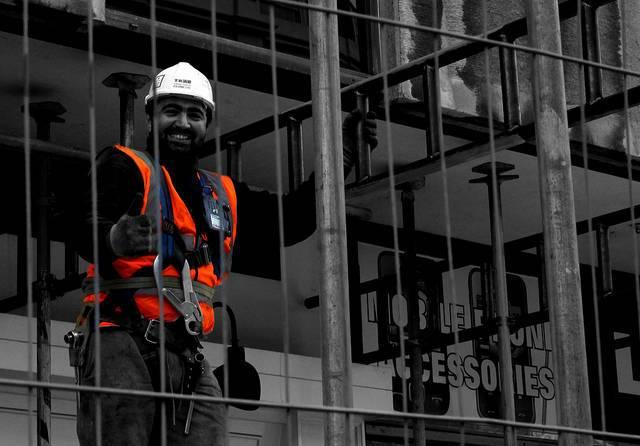

"Do you work outside the home?" my doctor asked during a recent checkup. It's a typical politically correct way to ask mothers if they work for pay. In fact I do, but I'm one of a growing segment of flexible work-from-homers who earn their salaries from a computer in the living room, so I wasn't quite sure how to answer.
Being "in the office" is a relative term when work can take place in any time zone, in any location, as long as there is wifi. Indeed, the very nature of work is changing right before our very eyes. The increased flexibility of work presents great opportunities for those with in-demand skill sets and the ability to engender trust and communication with distance employers. However, the rise of the gig economy presents huge challenges too. Lower wage employees who work in the gig economy lack many of the protections of traditional employment like healthcare, workers comp, job training and the job security of yore. And as of yet, the public sector hasn't stepped in to bridge the gap. On the 25th anniversary of its first conference, BSR tackled this thorny subject in a session entitled The 21st-Century Social Contract.
Like all the best panels, this one featured experts with quite different perspectives on this rich topic. Libby Reder, fellow at the Aspen Institute Future of Work Initiative, concerns herself with the risks facing the bulk of these in-demand workers and the policy and organizational tools workers can use to fight for better protections. Peter Leyden, Founder of Reinvent, has seen the opportunity the flexible workforce provides and earns his living helping companies and individuals take advantage. BSR CEO Aron Cramer rounded out the mix.
Workers who are available when someone needs their services, not necessarily when they need a paycheck, are called the "contingent workforce" according to Reder. This growing trend -- 30 percent of the workforce according to Leyden – is "driven by the mix of shareholder maximization, short-termism, and rules enshrined at state and federal level to treat certain types of workers one way and others another." She refers, of course, to the fact that traditional employment contracts include a range of services: even the lowest wage jobs in this category include a minimum wage, social security, unemployment insurance, leave to care for sick family members and workers compensation. Many more include vacation, sick time, regular wages, disability insurance, retirement and many more perks.
So-called Independent Contractors operate as mini-solo businesses and therefore receive none of these benefits. This set of separate classifications is the key to the rise of the gig economy. Every TaskRabbit, Lyft driver and Etsy crafter is his or her own employer, for better or worse. The absence of workplace protections is key to these companies' impressive profit margins. Reder offers a difficult challenge, "How will we re-architect the social contract we’ve made with the middle class? That a hard days work will be enough to support a middle class family." Indeed the social contract is "fraying at the edges."
Leyden counters the doom and gloom of the risk to workers. "This is good," he offers. It's the key to corporate profitability, since companies do not need to pay for workers' time when their services are not needed. Workers benefit too, from the increased flexibility and choice around which projects and teams to work with. "So much of the best talent in the world doesn’t want to be part of a company," he notes, "If we get this right it could be an awesome system for a lot of people." Indeed, the the "endorphins of entrepreneurship" as Reder calls them – are a key facet of today's workplace that would have been hard to find in the offices and on the factory floors of the 1950s.
So how do we protect against the bad while allowing for the good?
In short, we need to decouple benefits from the workplace. That can happen through a variety of means:
Corporate Leadership
Leyden sees opportunities for companies to take a leadership role. "Companies should take the high ground." For example, they could segment pay for independent contractors and provide separate payments into retirement and training accounts. Leyden points to the Reuther's Treaty of Detroit, a landmark trade union contract negotiated first with General Motors and then with Ford and Chrysler to give auto workers extensive health, unemployment, and pension benefits in exchange for agreeing not to strike.
Just like GM set the standard in Detroit, we’re gonna pay decent wages that go up with the cost of living. You need healthcare for the family? Need pensions? Great, we’ll throw money into pensions. You need vacation? You wanna be a real person, got a grievance, great we’ll give you unions. Workers have the same generic needs now and it’s totally doable. Have portable benefits. Aggregate. Technology makes it solvable.
Of course, this corporate leadership only came with worker pressure. Unions, in most cases, are much less common and powerful now. Reder posits that we might also explore associations, since these issues affect workers in many sectors. "What would be the AAA or NRA of independent workers look like?" Associations of independent workers could advocate for change at the state and federal level and pressure companies too.
When it comes to employers, she evokes the early days of corporate green team, "Just start. Start to measure. Go to HR and ask how has our workforce changed? How many full time, part time people do we contract with? Do we have best practices?" From measurement, of course, sustainability advocates know well, comes management.
Ultimately, much of the solution to the individual worker protection issues rests with the state and federal government. Even if they aren't focused on solving problems for the majority of Americans, they should be. It's our responsibility to hold them accountable.
Leyden summed things up with a prediction, "When people look back at early years of late 20th century, they'll see climate change, massive inequality and all the disruption these have caused. Everything is breaking so fast and it's so profound."
All we can do is be on the right side of history, advocating for the rights workers know they deserve.
Image credit: James Mackintosh, Flickr
Puerto Rico Grid Re-Build After Hurricane Maria: Tesla's Elon Musk Proposes, Whitefish Disposes
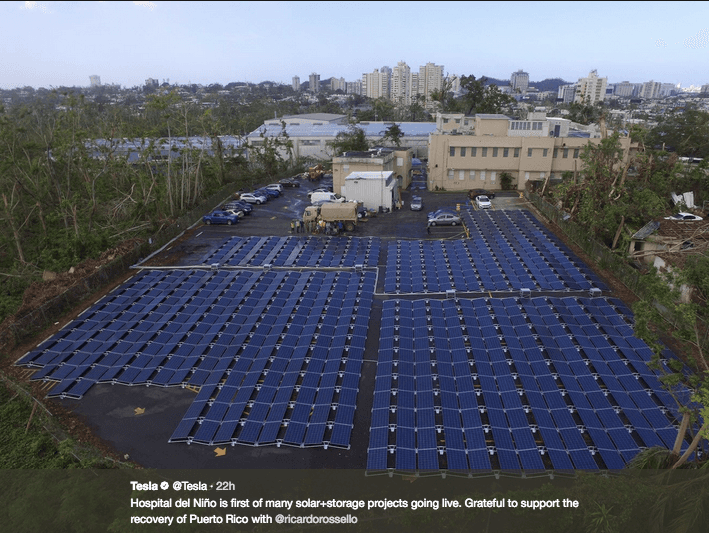

Sometime in the sparkling green future, if millions of U.S. citizens see their entire conventional fossil-fueled power grid destroyed by a hurricane, energy industry leaders will be tapped to replace it with the latest renewable energy and energy storage technology -- and cutting edge "smart" microgrid systems, too. Realistically, though, the 3.4 million U.S. citizens who happen to list Puerto Rico as their official residence should at least be able to count on a wealth of conventional grid experience to get their homes, businesses, hospitals and other essential services up and running again in the aftermath of Hurricane Maria.
Well, file this under D for Dream on, Klingon. A full month after Hurricane Maria struck Puerto Rico, most residents are still without power. Adding insult to injury, a hefty portion of the initial repair work -- including 100 miles of transmission line -- has been contracted out to a scantily staffed, inexperienced two-year-old startup company called Whitefish Energy, which lists its headquarters in Whitefish, Montana.
Something is rotten in the state of Montana
In what has become a widely reported bubbling scandal, Whitefish Energy won the largest contract so far to repair Puerto Rico's electricity grid, at $300 million.
Nothing about the contract seems ordinary. As described by The Washington Post, when disaster strikes, utilities ordinarily tap a longstanding mutual aid system to bring in experienced work crews from outside. The situation in Puerto Rico is complicated by its remote location, but it appears that PERPA (the Puerto Rico Electric Power Authority) gave the option of tapping APPA's aid network only a cursory look.
Whitefish had a staff of two at the time Maria struck, and it has been procuring workers through subcontracts with other utilities. According to the Post, those subcontracts also appear unusual and onerous:
Under the contract, the hourly rate was set at $330 for a site supervisor, and at $227.88 for a “journeyman lineman.” The cost for subcontractors, which make up the bulk of Whitefish’s workforce, is $462 per hour for a supervisor and $319.04 for a lineman. Whitefish also charges nightly accommodation fees of $332 per worker and almost $80 per day for food.
Although the company claims to be "on the ground" in Puerto Rico mere days after the hurricane struck, in the full month since then it has shipped in fewer than 300 workers.
In another oddity, Whitefish happens to be headquartered in the hometown of Interior Secretary Ryan Zinke, who has acknowledged an acquaintance with at the company's top executive.
As for experience, the Post dug up only two relevant contracts won by the company since its inception. One of those was a $1.1 million contract to upgrade a 4.8 mile length of transmission line, with a timeline of 11 months.
By way of comparison, last week the U.S. Army Corps of Engineers awarded a $240 million power restoration contract to a Texas-based company called Fluor. The company already has a history of work in Puerto Rico, which it mentions in a press release:
Fluor’s unique combination of government contingency operations and power experience, along with its 50-year presence in Puerto Rico, will enable ongoing efforts to repair transmission and distribution lines. The contract includes equipment evaluation and repair as well as work towards the re-energization and recommissioning of substations and switching stations.
Fluor also notes that it is a "global engineering, procurement, fabrication, construction and maintenance company" that has been "delivering innovative and integrated solutions across the globe" in its century-plus history. Its operations include renewable energy, too.
That sounds rather more reassuring.
Democratic legislators in Congress have asked for an investigation of the Whitefish contract, so stayed tuned for more on that.
In the meantime, Whitefish is apparently unhappy to see all the questions arising about how it captured this rich contract.
Elon Musk proposes renewables for Puerto Rico
Regardless of whether or not renewable energy is in Fluor's plans for Puerto Rico, clean tech entrepreneur Elon Musk is already on the job.
Musk is best known as the co-founder of the high profile electric vehicle manufacturer Tesla, which includes energy storage and solar development in its stable. Tesla has just started work on a large solar-plus-storage project for a children's hospital in Puerto Rico, Hospital del Niño.
That's just one project, but Musk has already helped to gin up interest in a renewable energy future for Puerto Rico. Bloomberg notes that Puerto Rico officials have also been in talks with Sonnen GmbH, Arensis Corp. and Sunnova Energy Corp., which also have a clean tech track record.
One question that could tip the scales is whether or not U.S disaster relief funding could be used to modernized Puerto Rico's power system rather than simply rebuild what Maria destroyed.
In a best case scenario, Puerto Rico's centralized, conventional power grid would be replaced by a network of microgrids.
That option has a fighting chance. Although Energy Secretary Rick Perry has been toeing the Trump administration line in support of large, centralized coal and nuclear power plants, his agency is also moving forward with a longstanding grid modernization initiative that leans on renewable energy integration and microgrids.
It's also worth keeping in mind that for all his nonsense on climate change, Perry was governor of Texas as the state accelerated its booming wind industry, and he has continued to champion renewables as Energy Secretary.
Photo (screenshot): via @Tesla.
Visa Invests $20 Million in Microloan Program for Women Entrepreneurs
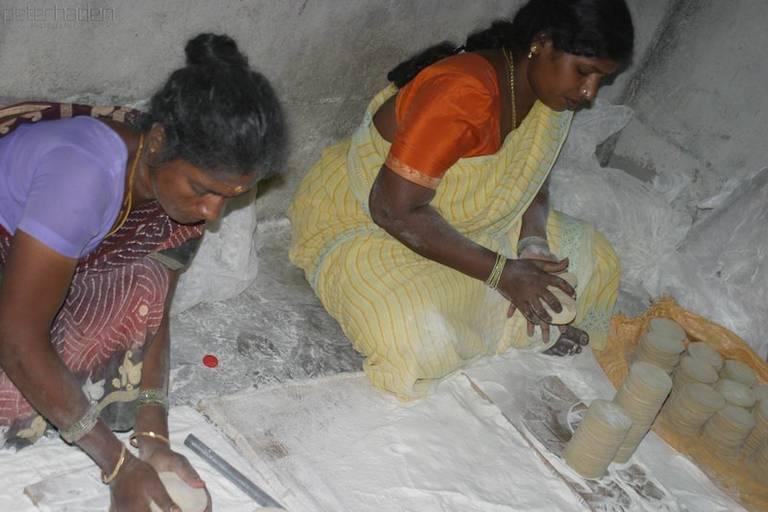

Visa says it has a new strategy to help women entrepreneurs. On Tuesday the global lender announced the launch of its new Visa Foundation and with it, a contribution of $20 million to the nonprofit Women's World Banking (WWB) to help "prioritize the growth of micro and small enterprises around the world." The money, which will be distributed to WWB over a five-year period, will be used to boost opportunities for women-led businesses in underserved communities where banks and other financial institutions are limited or nonexistent.
According to Stephen Kehoe, Visa's senior vice president for global financial inclusion, the new partnership will open a door for women-led enterprises.
"Women and women-owned businesses continue to be disproportionately excluded from accessing formal financial services, impacting hundreds of millions of individuals with a significant effect on families and communities,” said Kehoe." “By supporting measures to include women, there is a strong multiplier effect in terms of increased financial health for all. For this reason, the Visa Foundation chose to focus its first grant on women-owned enterprises and has selected Women’s World Banking as our first grant recipient.”
“One billion women worldwide are unbanked, a significant number of them business owners," said Mary Ellen Iskenderian, President and CEO of WWB. "Through this partnership, we will deliver solutions that drive women’s access and usage of innovative financial services, so that they create economic opportunity for themselves and their families.”
The two organizations have not said exactly how the money will be used, whether they will be distributed as microloans or grants and how applicants will be expected to qualify for the funds. However, Visa has laid out a series of objectives designed to develop products and services for eligible entrepreneurs and hopes to be able to provide services to as many as 50 million underserved business owners in Mexico, India, Egypt and Nigeria.
The microloan business has been growing in recent years, particularly in impoverished areas where farmers and entrepreneurs face difficult barriers in obtaining financing. According to a World Bank Enterprise Survey, " smaller firms are less likely to have access to capital – a factor that constrains their ability to grow and become more productive." Not surprisingly, the survey found " [access] to finance is disproportionately difficult for smaller firms in the least developed countries (LDCs), with 41 percent of SMEs in LDCs reporting access to finance as a major constraint to their growth and development." By comparison, 30 percent of firms in middle-income countries and 15 percent in high-income countries faced the same barriers.
That's especially true for women-owned busnesses, says WWB. About one-third of the 200 million small businesses in emerging economies that have no or little access to loans and other forms of credit are owned by women. Studies have shown that increasing access to women entrepreneurs and aspiring business owners has, in the past, often translated to better living standards for impoverished families and more stable access to education for the business owner's children.
But those stories of accomplishment and empowerment come from earlier days when small nonprofits, bent on helping impoverished families with no running water, no toilets and no collateral for loans had little hope of financial access, points out Smitha Radhakrishnan, associate professor in sociology at Wellsely College in Boston.
These days, Radhakrishnan notes, the road to success for low-income women business operators has become much more rocky and complex.
"[Today], microfinance has become a profitable industry that provides financial products to the poor that are too expensive for the rich, says Radhakrishnan, who quotes interest rates for microloans as often range "22- 90 [percent] per year." [Profitable] microfinance companies around the world now consider themselves providers of 'financial inclusion,' and not women’s empowerment, poverty alleviation, or even enterprise development."
That "mission shift," say researchers Phil Mader and Sophia Sabrow, is an important factor, as it can define whether struggling and aspiring business owners in developing countries really can financially benefit from microloan options.
"The proclaimed shift in strategy is found to consist less of rational innovation towards the aim of poverty alleviation than of “myth and ceremony” for the sake of organisational self-preservation," the writers argue.
And they aren't the only researchers to question whether credit products and services work for rural and impoverished business operators. Anjini Kochar, India Program Director and Senior Research Scholar at the Stanford Center on Global Poverty and Development observed that "repayment of official loans was accompanied by significant loans from relatives, friends and professional moneylenders," explains Emily Miller, who writes for the Center.
"High repayment rates, normally considered to be an indicator of the household’s strong financial position, actually hide very high levels of indebtedness to the informal sector,” said Kochar. At the time, Kochar was in India to study the link between credit indebtedness and child malnutrition.
Still, microloans are known to work when they are engineered for nonprofit or minimal-profit margins, and as Radhakrishnan notes, for women's empowerment and poverty alleviation, not just financial inclusion of a disregarded population. Organizations like Meketa, a nonprofit from the UK that provides microloans to aspiring Ethiopian entrepreneurs in high-risk poverty settings have helped to turn around the fate of isolated communities where funding is really nonexistent. Other nonprofits with low repayment rates designed to self-fund the programs have contributed to the same kind of success.
The question that Visa and the World Women's Bank will hopefully be working with, is whether credit products can really be designed to help lift women entrepreneurs out of debt, not just into the big, wide and expensive world of banking sector. They may find that microloan strategies continue to work best for their customers when the loans are underwritten by nonprofit organizations that can offer low repayment options and aren't wrestling with a demanding profit margin.
Flickr image: Peter Haden
How Millennials and Young Farmers Are Demanding CSR


By W.M. Chandler
Millennials have tipped the mark as the world’s largest generational population and make up the highest percentage of the workforce. A generation that demands a healthier and more rewarding work environment than their predecessors. One that doesn’t want to be associated with a company with poor environmental ethics or practices — no matter how high their paycheck. They are the leading the way in holding industries accountable for their corporate social responsibility and impact on people and the environment.
They have been raised in an era that has allowed them to have the internet at their fingertips from the moment they could hold an iPhone. The wealth of the information online keeps them informed and allows them to have their voice heard on millions of different platforms and websites every day. They are demanding better working conditions and that their employers hold themselves accountable for their ecological impact.
Due to growing up in a time period in which there were no major unemployment rate drops during their employable years, they have no problem simply quitting their job if their employer is unwilling to adhere to their personal ethical standards. According to Ohio University, a recent Deloitte survey found that 70 percent of millennials acknowledged that a company’s commitment to social responsibility influenced their choice to work there.
The millennial generation has been told of warming climates, the threats of pollution and have been encouraged to adopt positive environmental practices (i.e. recycling, composting) their entire lives. Most are refusing to accept working for anyone that doesn’t understand the need for change in business practices, especially in the agricultural and farming realm.
The new faces at local farmers markets are tending to look younger and younger. Concerned for the sourcing of their food, many of the millennial generation are leasing land to grow food for themselves and their communities. It is their way to say to factory farms and other businesses mired in conventional farming that if they aren’t going to change their ways, millennial consumers will no longer be their employees or consumers. One of the heaviest influences that consumers can have on the market is their purchasing power. Many millennials wish to see their food be ethically sourced, and to come from local and organic farms. If the market doesn’t supply the demand, they will do take it upon themselves to meet those needs.
In addition to millennials fighting for what they believe to be ethical, they are getting the education to do it. As a result, this generation has the highest amount of student debt than any other. In a survey done by the National Young Farmers Coalition, they found that 30 percent of young farmers (defined as working in agriculture for less than 10 years) pursued a college or university education before beginning their career. Educated or not, those that are working to start their own farms are finding pitfalls and barriers.
A report from The Heritage Foundation states, “Farm subsidies are intended to help struggling family farmers. Instead, they harm them by excluding them from most subsidies, financing the consolidation of family farms, and raising land values to levels that prevent young people from entering farming.” Farmers that receive government subsidies are subject to certain rules and regulations that promote pesticide, herbicide and antibiotic use that is proving harmful to the environment. Most independent farms refuse the help of government programs and funding to allow them to operate under their own code of ethics.
Organizations such as the National Young Farmers Coalition, have set out to create a new standard for farming practices. They aim to grow with integrity by insisting upon fair labor practices, helping to find affordable land for farmers to lease or purchase, emphasize the importance of family farms and condone only sustainable farming methods. By creating a new social norm for how their community’s food is grown, they hope to build a resistance against an unreliable infrastructure and in hopes of fighting against obesity in America.
Following the strides being taken by this large, young population may result in the implementation of socially responsible practices across the board, especially in the farming sector. What millennial farmers hope to have the world understand is that everyone has a stake in the global food system. It affects each individual, our water, our land and our air. It isn’t about a generational gap; it is about resisting systems that do not have sustainability in their operational plan.
W.M. Chandler is a Colorado native and works best with her head in the clouds. She is an avid researcher and enjoys writing about unfamiliar subjects. She writes passionately about nature and the outdoors, human connections and relationships, nutrition and politics. Follow her on Twitter @wmchandler1212.
Image credit: iStockEU advisory group sets out vision for sustainable finance
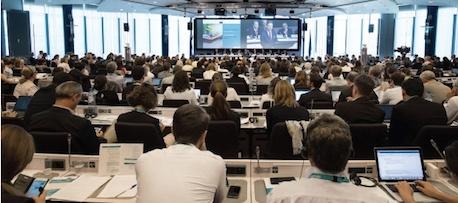
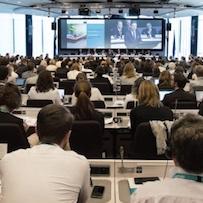
Calamitous Climate: A Tale of Two Countries Illuminates the Necessity of Preparation
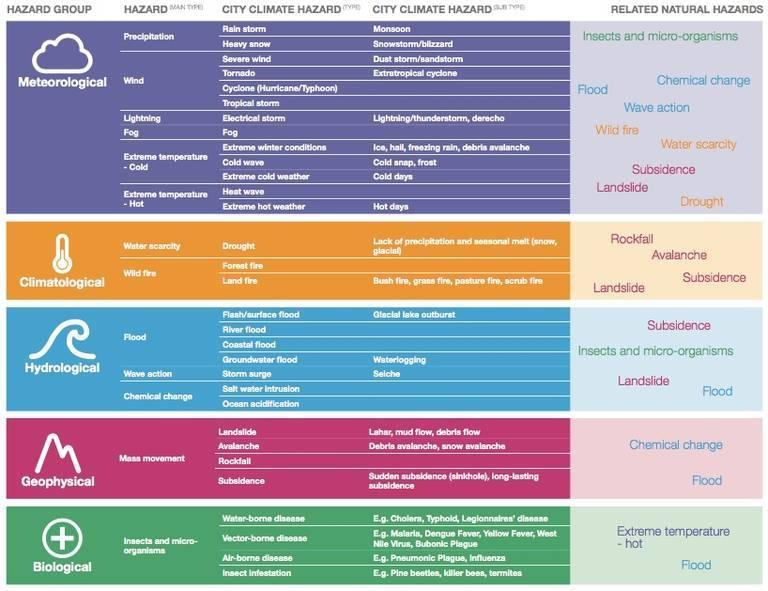

By Joyce Coffee and Rachel Jouan
In one month, three historic hurricane touched ground in the U.S. Now tragic wildfires surge in the west, intensified by an epic drought. Likewise, in France, 80 counties faced drought in August, 14,000 hectares of wildfires so far in 2017, more than double the traditional toll. As this extreme weather continues to dominate the headlines, what can city leaders do to protect their communities – and using municipalities in the U.S. and France as examples?
It’s worth exploring. But, first we should mull two critical climate questions that serve as foundations for our exploration. Are the enduring structures we build able to withstand climate change? And are climate risks and opportunities shared equitably within our communities?
And to be clear about the risks we face, they generally fall into three categories:
· Increasing mean temperatures and frequency of extreme heat: Scorching hot days and nights grow more frequent, along with the intensity and length of warm spells and heat waves. High temperatures dry vegetation and soils, potentially sparking more frequent fires, landslides or subsidence. Droughts become more frequent, threatening water supplies and aggravating conditions for wildlife. Increased heat hurts outdoor workers’ productivity and exacerbates illnesses, such as asthma and chronic pulmonary obstructive disease.
· Increasing extreme precipitation and floods: The timing, amount and type of precipitation is changing, causing more intense seasonal rain or snow and flooding. Floods can break down electricity, transport, water, sewage and telecom networks, triggering economic damages, especially from disrupting business continuity.
· Rising sea levels: Hotter air temperatures raise sea levels as warmer and less dense seas expand and polar ice sheets melt. Higher sea levels increase the risk of coastal storm surges and push salt water into wetlands, higher up tidal rivers and deeper into groundwater systems. This submerges property and damages infrastructure.
C40 – the network of global cities collaborating to provide climate solutions for their residents – offers a helpful climate hazard taxonomy to view these primary hazards and their related city climate hazards.
(ref: http://www.c40.org/researches/city-climate-hazard-taxonomy p.4)
So, how are cities to respond to the two climate questions? Here are five categories of municipal endeavors with examples of success from both France and the U.S.:
1. Disaster risk reduction
Integrating disaster risk reduction into urban development policies and practice requires a new, systems-oriented, multi-timescale approach to risk assessments and planning. It’s necessary to reflect emerging conditions within specific, more vulnerable communities and sectors as well as across entire metropolitan areas.
Baltimore’s Office of Sustainability is taking steps to ensure that families, especially those in under-resourced communities, are prepared to respond to emergencies. Its “Make a Plan, Build a Kit, Help Each Other” events let residents create emergency plans and essential preparedness and grasp how to respond in emergency.
2. Adaptations while reducing greenhouse gas emissions
Integrating mitigation and adaptation is a high priority for cities in planning, design, and architecture. Engineering, ecosystem and social-based solutions should be considered to generate actions with the greatest benefits.
For instance, in April 2017, New York City released preliminary Climate Resiliency Design Guidelines to support stronger and safer infrastructure and building designs in a hotter, more extreme weather- and flood-prone world. The guidelines incorporate predictive climate data into all city capital projects to anticipate hotter heat waves, heavier downpours and sea level rise. For instance, they use light-colored and reflective pavement and roofs, shade trees and other landscaping to decrease the urban heat island effect. They also decrease energy use for cooling and set storm drainage standards that require permeable pavement and other green infrastructure to increase stormwater absorption.
The Clichy-Batignolles urban project in the Paris area built a “climate-proof” urban area that is both attractive for residents during the summer time and able to absorb precipitation during heavy rain periods. A 10-hectares park – open 24 hours a day with pools, drinking fountains, water jets, along with cooling buildings that reflect sunlight and have green roofs, etc. – has reduced energy demand and stormwater treatment. The volume of stormwater treatment declined by 50 percent.
3. Risk assessments and climate action plans co-generated with the full range of stakeholders and scientists.
Processes that are inclusive, transparent, participatory, multisectoral, multijurisdictional and interdisciplinary prove to be the most robust because they enhance relevance, flexibility and legitimacy.
Cleveland’s asset-based Neighborhood Climate Action Toolkit was created in partnership with community development corporations. It helps residents to identify and advance neighborhood priorities that further the city’s climate action goals. In addition, Minneapolis unites community representatives and city staff to plan its Green Zones initiative. They actively avoid deficit-based planning, which focuses on the community’s vulnerabilities, and are building on existing community assets via access to a wealth of community knowledge and networks.
Paris’ adaptation strategy reflects a long process (2010-2015) that mobilized all departments and many institutional, operational and scientific partners. Key aspects of its design and application include raising awareness and recognition of the collective benefits of adaptation. In 2010, the exhibition, « +2 °C... Paris s’invente » (Plus two degrees Celsius, Paris invents itself) demonstrated how concrete adaptation will benefit all Parisians through development of a science-based adaptation strategy against extreme events and to ensure food supplies and foster a more sustainable city. The strategy included more than 100indicators (e.g., the number of Parisians who live more than seven minutes walking distance from a cool space; the number of free drinking fountains in Paris, the surface area in an electrically fragile zone in case of massive flooding).
4. Needs of the most disadvantaged and vulnerable citizens.
Greater climate change impacts impact the urban poor, elderly, minorities, recent immigrants and, otherwise, marginal populations. Equity and justice improve wellbeing and social and economic development are foundational to effective climate change action.
In Seattle, city and community leaders seek to deepen connections between race, social justice and environment. The Equity & Environment Initiative created The Community Partners Steering Committee to “ensure that those most affected by environmental inequities would lead in creating the agenda.” This process has highlighted community priorities that create climate action and social cohesion, including safety and walkability, public transit, green space and gardens and youth programming.
In Nice, social services put a targeted action plan in place affecting those most sensitive to climatic crisis. A database registered the most isolated and vulnerable based on medical and social services networks and local media. So, during heat waves, volunteers call and visit the most vulnerable residents every other day, offering advice on good practices to combat high temperatures. This initiative reduces the sensitivity of isolated and vulnerable people and increases the social link and solidarity between youth and elderly.
5. City climate adaptation described in terms of lives, livelihoods and dollars saved.
Quantifying the benefits of climate adaptation proves essential to attract future capital. Such access to both municipal and outside financial resources funds climate change solutions. Sound urban climate governance requires longer planning horizons, effective execution mechanisms and coordination. Connecting with national and international capacity-building networks helps to advance the strength and success of city-level climate planning and implementation.
Resources for the Future quantified the benefits of a green infrastructure investment around St. Louis on the Meramec Greenway. They figured the benefits reduced flood damage and enhanced property values by amounts three times greater than the flood damage-reduction benefits.
By buying property in urban areas from families who had been flooded often and volunteered to participate, Missouri saved roughly $100 million—earning a 212 percent return on its buyout investment.
Albuquerque and Santa Fe, New Mexico, as well as several Indian tribes worked with federal and state governments, water managers and companies to create the public/private Rio Grande Water Fund to restore forests and to pay for clean water protection and forest thinning to decrease the threat of wildfires.
Washington, D.C., issued the performance-based Environmental Impact Bond to reduce flood risks and ensure that city residents have access to clean water. Funds are invested in green infrastructure and paid back to social impact investors as performance targets are met.
Insurance company FM Global estimates that businesses that made a $7,400 investment to reduce extreme weather risk ahead of Hurricane Katrina averted an average of $1.5 million in losses.
Cities must start immediately to develop and apply climate action
We are in the greatest period of urbanization and rapidly changing climate in recorded human history. Cities that ask the climate adaptation questions now and take steps such as those described above will create the transformation that saves lives and livelihoods in the face of climate shifts. In the process, they will avoid counterproductive maladaptations; help deter locking-in that can damage long-lived investments and infrastructure systems; and ensure cities’ potential for the transformation required to lead climate change. Cities that create resilience will avoid being in the headlines after disasters. Rather, as Chicago has, they will begin to tout their resilience as a business asset.
Joyce Coffee is president of Climate Resilience Consulting, working with leaders to create strategies that protect and enhance markets and livelihoods through resilience to climate change. Rachel Jouan is founder of Climate Adaptation Consulting in France, working with local, national and international governments to increase resiliency through adaptation to climate change.
U.S. Energy Dept. Aims For "Extreme" Fast EV Charging -- Without Bumping Up Costs


Despite the Trump Administration's rhetoric on fossil fuels, the U.S. Department of Energy is still keen on seeing more electric vehicles on the road. The agency has been pouring millions into research aimed at bringing EV costs down, to help pick up the pace of adoption. However, cost is just one obstacle. Another major roadblock is EV charging, which takes significantly longer than filling a gas tank.
The Energy Department has worked out a pathway to achieving high-speed EV charging that is more competitive with gassing up. The only question is, who's gonna pay for all this?
EV charging is a major problem -- and a solution
In the introduction to a newly released report on electric vehicles and EV charging times, the Energy Department's Vehicle Technologies Office drifts far away from President Trump's usual rhetoric on "energy dominance:"
Decreasing energy consumption across the U.S. transportation sector, especially in commercial light duty vehicles, is essential for the United States to gain energy independence. Recently, powertrain electrification with plug-in electric vehicles (PEVs) have gained traction as an alternative due to their inherent efficiency advantages compared to the traditional internal combustion engine vehicle (ICEV).
The report focuses on all-electric, battery powered EVs (not gas-electric hybrids or fuel cell electric vehicles). It notes that powertrain costs have been plummeting, but the market for EVs is still hovering around a barely perceptible level of about 1 percent of sales.
Based partly on studies showing that EV adoption shoots up where faster EV charging stations are available, the Energy Department posits that slow charging times still throw a formidable barrier up against widespread EV adoption.
Interestingly, studies also show that fast-charging stations are rarely used even in areas where they are available. That's possibly because EV owners mainly prefer to charge at home, or charge at their workplace, where they can plug in and leave their car to charge for longer periods. In effect, public fast-charging stations are mostly a buffer against range anxiety. EV owners like to know they can charge up relatively quickly on the road, even if they rarely need to do that.
Who's gonna pay for all this?
Today's fastest-charging EV stations are still significantly slower than the time it takes to fill a gas tank, but improvements are already in store.
Volkswagen, for example, is working on 350-kw EV charging stations in California as part of its "diesel-gate" settlement.
Plans are even more ambitious in Europe, where a group of auto manufacturers has been putting together a network of 400 extreme fast-charging stations at the 350-kw level.
To top them all, the new Energy Department report draws a scenario for "extreme fast" EV charging at the level of 400 kw or more.
The 400-kw mark is essential to meeting the agency's goal of increasing EV range to 300 miles while reducing charging times to a maximum of 15 minutes.
The problem is that extreme fast-charging requires new -- and significantly more expensive -- EV battery technology to go with it.
That leaves the Energy Department with a dilemma: EVs will become far more convenient, but EV ownership will become more expensive and exclusive.
Group hug for U.S. taxpayers!
With a fast-charging vehicle for the 99 percent in mind, the Energy Department has just announced a new $15 million funding program for early stage R&D aimed at holding EV battery costs down while introducing new technology compatible with extreme fast-charging.
Aside from tweaks to the battery technology itself, the new funding initiative also addresses costs associated with power transmission and distribution infrastructure that will be needed to hit the extreme fast-charging mark, including charging stations.
The application process is just getting under way and the Energy Department expects to select awardees next spring, so stay tuned for updates.
Meanwhile, the funding opportunity announcement for the new EV initiative includes a rather sharp indictment of the Trump administration's energy policy:
...Growing our economy requires transportation, and transportation requires energy. The transportation sector currently accounts for 70% of U.S. petroleum consumption. Twenty five percent of U.S. petroleum consumption is imported. The U.S. sends more than 10 billion dollars per month overseas for crude oil, and the average U.S. household spends nearly one-fifth of its total family expenditures on transportation, making it the second-most expensive spending category after housing. Oil price volatility also affects our national economy and household budgets, causing difficult fluctuations in annual household budgets and business operating expenses.
If you caught that thing about "oil price volatility," that's shorthand for the fact that the petroleum marketplace is global. No matter how much oil the U.S. produces, onshore or offshore, gasoline consumers will always be at the mercy of global price swings. That volatility factor can be reduced to a minimum in markets that rely on the killer combination of renewable energy plus storage.
It's also interesting that the Energy Department has gone out of its way to point out that transportation costs have a stranglehold on household budgets. EV adoption could ultimately help bring that proportion down, and enable households to spend more income on, well, just about anything else.
Photo (cropped): US DOE, Vehicle Technologies Office.
Zurich-Based Fund Generates Impressive Returns from Sustainable Development


Conventional wisdom states investment funds should focus on stable companies with long track records of steady returns. Those investors who can stomach a little more risk may gravitate towards aggressive growth funds that can reap big returns by inventing in companies with undervalued stocks, recent IPOs or companies' securities that have a long history of volatility.
One Zurich-based, fund, however, is generating wealth for investors while boosting sustainable development opportunities worldwide. Led by a portfolio manager with 25 years of experience who has conducted business in over 40 countries, this fund invests about $1.2 billion a year in ventures across the globe - and doing so in places usually off most investors' radar, from Egypt to Bhutan.
ResponsAbility currently manages approximately $3.3 billion in assets. The fund evaluates what it sees as promising investment opportunities in developing countries and completes about 500 various transactions annually. Managers of the fund claim that each of these investments cultivates inclusive growth and shared prosperity. ResponsAbility focuses on three sectors, energy, finance and food. Meanwhile, both retail and institutional investors can purchase both private equity and and private debt offerings.
According to a recent article on Bloomberg, ResponsAbility seeks a net return of between 15 and 18 percent annually for its agriculture private equity investments - and these funds' largest investors happen to be Swiss pension funds.
One of ResponsAbility's marquee agriculture investments is Mountain Hazelnuts, based in Bhutan. The company seeks to work with thousands of small-scale farmers across the small Himalayan country to boost exports of this lucrative crop. Horticulture experts are currently developing seedlings best suited to thrive as trees along Bhutan's mountainsides, while an outreach team identifies potential farmers. If a farmer does not own suitable land for hazelnuts, then agreements are made with local landowners or government-owned land is leased for orchards. And Mountain Hazelnuts operates as a social enterprise inclusive of everyone; hazelnuts in particular are an attractive option for elderly farmers or families headed by women, as they tend to struggle with financial security.
For ResponsAbility, this Bhutanese hazelnut venture is a no-brainer. Currently, 70 to 75 percent of the world's hazelnut production is concentrated in Turkey; according to Quartz, one-quarter of all hazelnuts are grown around the eastern Anatolian town of Ordu. To have suppliers based in one region is a risk that keeps plenty of producers up late at night, including Nutella or retailers such as Trader Joe's. Backed by ResponsAbility's investment, Mountain Hazelnuts' 600 employees seek to change that dynamic, while boosting local incomes in rural areas and empowering women in the process.
ResponsAbility is also aggressively investing in the energy sector, and in regions where reliable power is needed the most.
Across Africa, ResponsAbility partners with various financial institutions and energy companies on renewable power projects. In Namibia, a 5MW solar project employs locals while boosting local energy security. Small-scale hydropower projects are also part of ResponsAbility's portfolio - and in Kenya, their combined 26 MW of clean power will electrify up to 200,000 households.
These projects are designed for the long term. Whether the end results are the scaling up of organic rice from Cambodia or cashews from Togo, these investments are not for buyers seeking a quick buck. But ResponsAbility's investments are certainly paying off, providing social and economic benefits in overlooked communities worldwide while generating steady returns for customers at home.
Image credit: Mountain Hazelnuts
Looking Ahead: A Guide to Future-Focused Decision Making


By Jenna Cyprus
By its very definition, sustainability is about preparing for the future. Sustainable strategies are ones that can be carried out, indefinitely, without any finite limitation on resources or deliverability. Present-focused decisions can be valuable, and are sometimes necessary, but they intentionally ignore future repercussions. If you want your company to succeed, you’ll need to spend more time and money on future-focused endeavors—but what exactly does that mean, and how can you get there?
Why future-focused decisions are often better
- They prioritize long-term objectives. First and most obviously, future-focused decisions prioritize long-term objectives, so they pay off in the long term. If you make a decision that helps you only today, the benefit is going to be short-lived. The tradeoff is, of course, those payoffs won’t come for several years.
- They have more time to be adjusted. Long-term goals need to be pursued over the course of many years, rather than months or weeks. This gives them more time and more opportunities to be adjusted. This allows you to adapt to new circumstances and polish your plan before it’s fully carried out, often improving its efficiency or focus.
- They come with a higher ROI. Overall, long-term investments tend to pay off in higher proportions to the original investment amount. This is because they have a longer period of time to mature (in addition to being more adaptable).
- Long-term equity investments. Consider the world of equity investing. It’s possible to run a day trading-style strategy, buying and selling stocks within a day to maximize profit, but it’s almost always better to buy and hold for the long term, or at least invest in futures, which give you higher leverage and a long-term focus. You’ll be forfeiting a significant share of your money temporarily, but the long-term gains are worth it.
- Clean energy installations. Most companies depend heavily on coal and other fossil fuels, or at least traditional forms of energy for the bulk of their operations. That’s because investing in clean energy, like wind and solar, can be expensive. A single building may require hundreds of thousands of dollars of equipment, which could feasibly pay off—but only after several years of operation. This is a decision that doesn’t carry an immediate benefit (other than public recognition), but is vital if you want to save money and protect the environment long-term.
- Dramatic process overhauls. Companies are also reluctant to undergo major changes to the way they do business; they’d rather stick to what they know works decently than take a risk on something that could turn out excellent or terrible. For example, while many people cite “New Coke” as a classic example of poor company decision making, the investment Coca-Cola made into creating a new, better recipe was a reasonable business decision; it cost over $4 million to conduct research, and they ended up with a product that people objectively preferred in blind taste tests. Coca-Cola was willing to make the investment and take the chance because they wanted an even more competitive product.
- Major staffing changes. It’s never easy to let someone go at your company, and it’s even harder when that person is in a leadership role. Still, sometimes it’s necessary to make staffing changes to maximize the potential growth of your organization. Any costs and challenges you face in procuring new, better talent are likely worth it.
- Infrastructural improvements. Making major changes or additions to your current infrastructure is costly, time-consuming, and frankly, a pain for everyone involved. But if planned properly, it could revolutionize how you operate. On a large scale, the transcontinental railroad is a perfect example of this; it took many years to complete, but once in place, it transformed the United States into a single, cohesive, connected entity rather than independently acting bits and pieces.
So how can you tell if a decision is future-focused? And if it is, how can you go about making it in a way that stakeholders will approve of?
- Set the right tone. Many organizations use a “brand voice” to align their employees under the same set of values, principles, and behaviors. If you want your managers and employees to make more future-focused, sustainable decisions, the tone needs to come from the top; you need to restructure and consistently reinforce this tone.
- Zoom out. When you’re discussing how to move forward, it’s easy to get stuck thinking about today, rather than tomorrow. Try to ignore perspectives based on how you currently feel about your business, and what you’re currently doing. Instead, think more abstractly and higher-level. You can improve your ability to visualize this by taking the perspective of people outside your organization, who won’t be affected by the costs as immediately as you will.
- Do more research. Chances are, if you look hard enough, you’ll be able to find objective data and numbers that prove your future-focused decision is more valuable to you. Do more research, and you’ll be able to prove to yourself and others that this line of effort is worth it. It’s hard to argue against math equations that logically conclude that one decision is better than the other.
- Chart out a timeline. If you’re concerned about how your changes will play out, or what might happen in the meantime, chart out a timeline of hypothetical events. You can also prepare for the unexpected by charting out parallel “worst-case” and “best-case” scenario timelines. This helps you visualize how your decision will unfold over the course of months and years, rather than hours and days, and compensates for at least some variability in your decision.
- Solicit opinions. Hear out other members of your board and team. They’ll help you form a fuller perspective of the organization as a whole. Obviously, you can’t make your decisions based solely on what other people think, but the more perspectives you gather, the more objective you’ll be in your reasoning.
- Be proactive. If you see a plan that has short-term benefits and long-term consequences, call it out. You may not be able to prevent every similar maneuver, but the more proactive and vocal you are about the importance of sustainability, the more your team’s decisions will start to drift toward emphasizing the future.
- Delegate responsibilities. Task your managers and supervisors with executing their own future-focused decisions, and put them in charge of ensuring their subordinates do the same. All of your managers should be tasked with adopting and nurturing future-focused mentalities.
- Tie everything back to the bottom line. If you’re in a position to prove the worth of your decision-making skills, or if you need approval to follow through on a project, tie everything back to the bottom line—profitability—when making your pitch.
- Find a balance. Obviously, not all of your decisions can be based on the developments of the next decade. You will have to incorporate some short-term decision making. The key is to find a balance, rather than relying on one over the other.
Everything starts with adopting a different mentality for all your decisions, big and small; think about the impact they’ll have in the future, whether that’s in six weeks or six years, rather than the costs and challenges they’ll bring you in the immediate future. When you make sustainability your biggest priority in company direction and decision making, you open the door to much better opportunities.
RECAP: #CaesarsPPP - People Planet Play - w/ Caesars Entertainment


Today, Caesars Entertainment and TriplePundit came together at #CaesarsPPP to discuss “People Planet Play” - corporate social responsibility and citizenship at Caesars Entertainment.
The world’s most diversified gaming and entertainment company has released its eighth annual Corporate Citizenship Report, entitled “People Planet Play,” detailing Caesars’ sustained progress and leadership across its many corporate social responsibility initiatives.
The name “People Planet Play” is also Caesars’ new platform that clearly communicates citizenship at all levels of the business and reaffirms the company’s’ commitment to its employees, communities, environmental excellence, and Responsible Gaming.
During #CaesarsPPP, discussed the following and much more:
- International Growth In early October Caesars emerged from months of intensive negotiations to finalize a restructuring plan that will allow for accelerated growth in international markets. Chief Marketing Officer for EMEA, Sarah Sculpher, will discuss a breadth of global citizenship topics including growth in the UK, where Caesars has established the industry’s gold standard Responsible Gaming program, and newly established diversity goals in Egypt, where the unemployment rate for eligible women is almost triple that of men.
- The ROI of Environmental Sustainability The impact of CSR is not easy to measure, and tying it to financial outcomes like revenue growth is even trickier. HRSC VP of Marketing Beau Swanson will share the outcomes of the focused marketing effort including what worked, what didn’t, and what the payback can be.
- The HEROs of Atlantic City - Caesars employee volunteer program – HERO – has been active for more than 20 years. From support of Second Wind Dreams during Senior Appreciation Quarter to raising money for the American Cancer Society through the annual Battle of the Bras and so much more, the Atlantic City team embodies the spirit of HERO. PR Director Noel Stevenson will give us a closer look at what makes the AC region so special.
"The eighth annual Citizenship Report underscores Caesars’ leadership and commitment to operate responsibly," said Mark Frissora, President and CEO of Caesars Entertainment. "To us this means making a sustained, positive impact that benefits our customers, employees and the communities that host our properties. People Planet Play will help these stakeholders understand where we focus and commit resources to drive responsible fun and business practices."
FEATURED GUESTS:
- Gwen Migita (@CitizenCaesars) - Vice President Sustainability & Corporate Citizenship
- Sarah Sculpher (@EmpireCasino) - Chief Marketing Officer for EMEA
- Beau Swanson (@HarrahsSoCal) - HRSC VP of Marketing
- Noel Stevenson (@HarrahsResort) - PR Director
About Caesars Entertainment
Caesars Entertainment Corporation (“CEC”) is the world's most diversified casino-entertainment provider and the most geographically diverse U.S. casino-entertainment company. CEC is mainly comprised of the following three entities: the majority owned operating subsidiary Caesars Entertainment Operating Company, wholly owned Caesars Entertainment Resort Properties and Caesars Growth Properties, in which we hold a variable economic interest. Since its beginning in Reno, Nevada, 79 years ago, CEC has grown through development of new resorts, expansions and acquisitions and its portfolio of subsidiaries now operate 47 casinos in 13 U.S. states and five countries. The Company's resorts operate primarily under the Caesars®, Harrah's® and Horseshoe® brand names. CEC's portfolio also includes the London Clubs International family of casinos. CEC is focused on building loyalty and value with its guests through a unique combination of great service, excellent products, unsurpassed distribution, operational excellence and technology leadership. The Company is committed to environmental sustainability and energy conservation and recognizes the importance of being a responsible steward of the environment. For more information, please visit www.caesars.com. Also be sure to follow @CitizenCaesars on Twitter or Facebook and visit the Corporate Citizenship blog at www.caesarscitizenship.caesarsblogs.com.